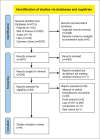Effects of High-Intensity Interval Training on Central Blood Pressure: A Systematic Review and Meta-Analysis
- PMID: 37098987
- PMCID: PMC10263426
- DOI: 10.36660/abc.20220398
Effects of High-Intensity Interval Training on Central Blood Pressure: A Systematic Review and Meta-Analysis
Abstract
Central blood pressure (cBP) is considered an independent predictor of organ damage, cardiovascular events and all-cause mortality. Evidence has shown that high intensity interval training (HIIT) is superior to moderate-intensity continuous training (MICT) for improving cardiorespiratory fitness and vascular function. However, the effects of these aerobic training modalities on cBP have not yet been properly reviewed.This meta-analysis aims to investigate to effects of HIIT versus MICT on cBP.We conducted a meta-analysis of randomized controlled trials that compared HIIT versus MICT on cBP. Primary outcomes were measures of central systolic blood pressure (cSBP) and central diastolic blood pressure (cDBP). Peripheral systolic blood pressure (pSBP) and diastolic blood pressure (pDBP), pulse wave velocity (PWV) and maximal oxygen uptake (VO2max) were analyzed as second outcomes. Meta-analysis of mean differences (MD) was conducted using the random effects model.Our study included 163 patients enrolled in six trials. We found that HIIT was superior to MICT in reducing the cSBP (MD = -3.12 mmHg, 95% CI: -4.75 to -1.50, p = 0.0002) and SBP (MD = -2.67 mmHg, 95% CI: -5.18 to -0.16, p = 0.04), and increasing VO2max(MD = 2.49 mL/kg/min, 95% CI: 1.25 to 3.73, p = 0.001). However, no significant differences were reported for cDBP, DBP and PWV.HIIT was superior to MICT in reducing the cSBP, which suggests its potential role as a non-pharmacological therapy for high blood pressure.
A pressão arterial central (PAc) é considerada um preditor independente de lesão de órgão, eventos cardiovasculares e mortalidade por todas as causas. Evidências mostram que o treino intervalado de alta intensidade (HIIT) é superior ao treino contínuo de intensidade moderada (MICT) na melhoria da aptidão cardiorrespiratória e da função vascular. No entanto, os efeitos dessas modalidades de treino aeróbico sobre a PAc não foram propriamente revisados. Esta metanálise tem como objetivo investigar os efeitos do HIIT versus MICT sobre a PAc.Conduzimos uma metanálise de ensaios controlados randomizados que compararam HIIT versus MICT sobre a PAc. Os desfechos primários foram Pressão Arterial Sistólica (PAS) central (PASc) e Pressão Arterial Diastólica central (PADc). A PAS periférica (PASp), a PAD periférica (PADp), a Velocidade de Onda de Pulso (VOP) e a captação máxima de oxigênio (VO2max) foram analisadas como desfechos secundários. A metanálise das diferenças médias (DM) foi conduzida usando modelos de efeitos aleatórios.Nosso estudo incluiu 163 pacientes recrutados em seis ensaios. Encontramos que HIIT foi superior ao MICT em reduzir PASc (DM = -3,12 mmHg, IC95% -4,75 – 1,50, p = 0,0002) e PAS (DM = -2,67 mmHg, IC95% -5,18 – -0,16, p = 0,04) e aumentar VO2max (DM = 2,49 mL/Kg/min, IC95% 1,25 – 3,73, p = 0,001). No entanto, não foram relatadas diferenças quanto à PADc, PAD ou VOP. O HIIT foi superior ao MICT em reduzir PASc, sugerindo seu potencial papel como uma terapia não farmacológica para a pressão arterial elevada.
Conflict of interest statement
Potencial conflito de interesse
Não há conflito com o presente artigo
Figures










References
-
- World Health Organization . Fact sheet on cardiovascular diseases (CVDs) Geneva: WHO; 2022. [cited 2020 Jul 29]. https://who.int/news-room/factsheets/detail/cardiovascular-diseases-(cvds) Internet.
-
- Williams B, Lacy PS, Thom SM, Cruickshank K, Stanton A, Collier D, et al. Differential Impact of Blood Pressure-Lowering Drugs on Central Aortic Pressure and Clinical Outcomes: Principal Results of the Conduit Artery Function Evaluation (CAFE) Study. Circulation . 2006;113(9):1213–1225. doi: 10.1161/CIRCULATIONAHA.105.595496. - DOI - PubMed
Publication types
MeSH terms
LinkOut - more resources
Full Text Sources
Medical
Miscellaneous

